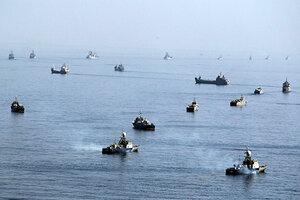Oil prices: What happens if Iran shuts down the Strait of Hormuz?
About 35 percent of the world’s seaborne traded oil moved through the Strait of Hormuz in 2011. Energy analysts don’t doubt that Iran could disrupt the flow of oil in the strait if it wants to.

Iranian ships participate in a naval parade on the last day of the Velayat-90 war game on the Sea of Oman near the Strait of Hormuz in southern Iran on Tuesday.
Ebrahim Norouzi/Jamejamonline/Reuters
New York
Iranian saber rattling about shutting down the Strait of Hormuz is causing a run-up in the price of oil – to $103 a barrel, a 4.25 percent increase on Tuesday alone.
How much higher could the price of oil go? What is the worst-case scenario?
If the rhetoric doesn’t calm down, it may not be long before the price of oil moves into the $110- to $125-a-barrel range, energy analysts say. But any movement beyond that will depend on what happens: Does Iran actually try to thwart ships that want to use the strait to transport oil? How would the US Navy or other naval powers react to that?
“Look at what happened to oil prices once hostilities started in Libya,” says John Kilduff, founding partner of Again Capital, an oil trading firm in New York. “And that’s small compared to what we are talking about in the straits.”
At issue is a significant amount of the world’s oil that moves by sea. In 2011, about 17 million barrels of oil per day, or about 35 percent of the world’s seaborne traded oil, moved through the Strait of Hormuz, the US Energy Information Administration estimates. Much of this oil flows to Asia – Japan, China, India, and other emerging economies. But some of the oil flows to Europe, and a relatively small amount – some 1.1 million barrels per day – goes to the United States.
The tensions come at a time when different forces are at work on the oil markets. Economists believe Europe is either in recession or just entering one. Oil demand from the US has remained modest.
“The tensions with Iran affect the price of oil because of the uncertainty of future supply, [which] puts pressure on prices, [while] the uncertainty of deteriorating economic growth in Europe – and how that might spread – puts downward pressure on prices,” says Tancred Lidderdale, an energy analyst at the Energy Information Administration in Washington.
The Iranian threats have taken place as the value of its currency has plunged, after President Obama signed into law a bill that targets the Iranian central bank – part of US efforts to pressure Iran to halt its nuclear program. The Iranian currency, the riyal, sank as Iranians tried to buy dollars.
If the Iranians were to start hostilities, there is no telling where it would lead, says Sarah Emerson, president of Energy Security Analysis Inc. in Wakefield, Mass. “It could escalate into retaliation against the nuclear sites in Iran; Israel could retaliate,” she says. “The worst case is that there is literally military action in the Gulf between the two sides.”
If that were to happen, the price of oil would almost certainly soar, says Mr. Kilduff. However, he thinks any military action is not likely to happen for some time. “Diplomacy can take a while,” he reasons.
Still, energy analysts don’t doubt that Iran could disrupt the flow of oil in the strait if it wants to.
“The Iranians can shut it down,” Mr. Kilduff says. “The US Navy has acknowledged Iran has the ability to do it as well.” But he adds, “The US Navy also has the ability to unblock it.”
Some parts of the strait are so narrow that the Iranians could sink barges or freighters to block the passage of other vessels. On Monday, Iran claimed to have fired a cruise missile that it said illustrated how it could control the strait.
“We would dredge the straits and get it open again,” Ms. Emerson says. “It would be a big deal to do it, but there would be all hands on deck,” she says. For example, she says, the Chinese Navy might well take part in any effort to keep the strait open. “If that were to happen, there would be a new era of Chinese activism in the world,” she says.
The Chinese count on oil moving through the Gulf, Emerson notes. In fact, the Chinese import about 550,000 barrels of oil per day from Iran, which would not be able to export its oil through the strait either if it shut the waterway down.
“When it comes to this kind of action by the Iranians, who are they hurting?” says Emerson. “They would be hurting their main customers, the Asians and other developing nations. They would not be poking the US in the eye.”
That’s because the bulk of US imports, which are about 9 million barrels of oil per day, come from places such as Canada, Mexico, Brazil, Africa, and Europe. Also, with a stockpile of more than 700 million barrels of oil in the Strategic Petroleum Reserve, the US could draw down from it over 466 days at a rate of 1.5 million barrels of oil per day.
By comparison, the US imports about 1.8 million barrels of oil a day from the Middle East – about 1.1 million barrels from Saudi Arabia.

